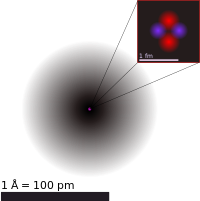
Photo from wikipedia
Abstract The present work embodies outward oxygen atom transfer (OAT) reaction from pyridylbenzoxazole (L1) chelated oxorhenium(V) complex of type [ReOCl3(L1)], 1 towards oxophilic PMe2Ph resulting in the formation of reduced… Click to show full abstract
Abstract The present work embodies outward oxygen atom transfer (OAT) reaction from pyridylbenzoxazole (L1) chelated oxorhenium(V) complex of type [ReOCl3(L1)], 1 towards oxophilic PMe2Ph resulting in the formation of reduced Re(III) derivative [Re(OPMe2Ph)Cl3(L1)], 4 containing oxidised phosphine trans to azole nitrogen. Another possible isomer (4a) having oxidised phosphine trans to pyridyl nitrogen has not been isolated. Structural elucidation of 4 reveals meridional disposition of three Cl atoms around the metal featuring distorted octahedral geometry. DFT analysis of isomers of type [Re(OPMe2Ph)Cl3(L1)] (4 and 4a) confirms isoenergetic nature in gas phase, however, stereospecific binding of L1 to Re(III) centre affording 4 as exclusive product is attributed to crystal packing force. 1 → 4 redox transformation has also been attended with the change in singlet → triplet spin state of the metal. Triplet state of 4 is more stable by ca. 15 kcal mol−1 compared to the singlet state in gas phase. Two electron paramagnetic nature (2.13 μB) in solid state affirms triplet ground state characterised with strong orbital coupling. Kinetic data for 1 → 4 transformation suggests associative pathway (ΔS≠ = ∼−36 J/K/mol) with no major structural reorganisation in the primary coordination sphere of the substrate and the reagent (ΔH≠ = ∼+10 kcal mol−1) to reach the transition state. Pyridylbenzthiazole (L2) chelated oxorhenium(V) complex of type [ReOCl3(L2)], 1b also reacts with PMe2Ph in a same manner to from [Re(OPMe2Ph)Cl3(L2)], 4b where the pyridyl nitrogen lies trans to phosphineoxide moiety unlike 4. The second order rate constants of OAT to PMe2Ph for [ReOCl3(L1)] are nearly two times higher than that of [ReOCl3(L2)] at all recorded temperatures due to difference in azole heteroatom electronegativity, ReV O bond length and ReVI/ReV reduction potential.
Journal Title: Polyhedron
Year Published: 2019
Link to full text (if available)
Share on Social Media: Sign Up to like & get
recommendations!